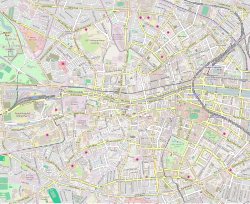Dublin Writers Museum
Músaem na Scríbhneoirí, Baile Átha Cliath | |
 | |
| Established | November 1991 |
|---|---|
| Location | 18 Parnell Square, Dublin |
| Coordinates | 53°21′16″N 6°15′50″W / 53.354383°N 6.26401°W |
| Public transit access | Dublin Bus route 46E |
| Website | writersmuseum |
The Dublin Writers Museum was a museum of literary history in Dublin, Ireland. It opened in November 1991, and was hailed as an "iconic" museum in Dublin.[1] It closed during the Covid-19 pandemic, and was brought to an end in 2022 without ever reopening.
History
[edit]
Maurice Gorham, journalist and author, proposed the idea of starting a literary museum in the 1970s.[2] The museum was opened on 18 November 1991, run by Dublin Tourism.[1] Its aim was "to promote interest in Irish literature as a whole and in the lives and works of individual Irish writers".[2] It was located in 18 Parnell Square, and consisted of two eighteenth-century buildings.[1][3] The main building, a red-brick Georgian-style house, had been used by George Jameson, son of the Jameson family, who owned Jameson Irish Whiskey.[1] Michael Stapleton, stuccodore from Dublin, decorated part of the main building.[3] Gorham Library, which commemorated its founder Gorham, was also set up on the upper floor.[4] The annexed building had a coffee shop, bookshop, and lecture room.[2]
David Norris launched his presidential campaign ahead of the Irish presidential election at Dublin Writers Museum on 5 October 2011.[5][6]
In 2012, Dublin Tourism was merged into Fáilte Ireland, and the museum had also been run by Fáilte Ireland since then.[7]

Having opened in 1991, the museum closed in March 2020 due to the Covid-19 lockdown.[7] It did not reopen. Set up by Dublin Tourism, it was transferred to Bord Failte in 2012. Bord Failte commissioned a report on its future in 2020, which concluded that it had become dated relative to modern expectations, so in 2022, the decision to end the operation permanently was made.[7] Two staff retired, two were allocated other Bord Failte duties. Announcements on the future of owned and lent artifacts were to follow.[7] Fáilte Ireland is still in charge of the museum artifacts after its closing.[7]

It is proposed that the building in 18 Parnell Square should be used as a museum to commemorate Harry Clarke, a stained glass artist from Dublin.[8]
Exhibitions
[edit]
The museum collected and exhibited various artifacts related to Irish writers.[1] It owned manuscripts, first editions, portraits, and personal mementos of many writers, including Jonathan Swift, Oscar Wilde, Bram Stoker, George Bernard Shaw, James Joyce, Samuel Beckett, Patrick Kavanagh, William Butler Yeats, Brendan Behan, Seamus Heaney, Brian Friel, Edna O'Brien, Roddy Doyle, Martin McDonagh, and Colm Tóibín.[1] It exhibited Jonathan Swift's coffee pot, the first edition of Bram Stoker's Dracula, Samuel Beckett's telephone, James Joyce's typewriter, and Brendan Behan's union cards and letter.[3][9] It also had a replica of Book of Kells.[10] Its exhibition was said to be filled with the belongings of "titans of Irish literature", although "most of those represented here are male and deceased".[11]
References
[edit]- ^ a b c d e f Klein, Julia M. (15 November 2011). "Celebrating the Mordant, Witty and Darkly Romantic". Wall Street Journal. ISSN 0099-9660. Retrieved 1 August 2022.
- ^ a b c Kilfeather, Siobhán Marie (2005). Dublin : a cultural history. Oxford: Oxford University Press. p. 195. ISBN 978-0-19-518201-9. OCLC 56876802.
- ^ a b c "Dublin Writers Museum | Dublin, Ireland | Sights". www.lonelyplanet.com. Retrieved 1 August 2022.
- ^ Kilfeather, Siobhán Marie (2005). Dublin : a cultural history. Oxford: Oxford University Press. p. 196. ISBN 978-0-19-518201-9. OCLC 56876802.
- ^ "Norris: Voters can decide on my credibility". Irish Examiner. Archived from the original on 7 October 2011. Retrieved 5 October 2011.
- ^ Carroll, Steven; Nihil, Cían. "Norris got TCD disability pay". The Irish Times. Archived from the original on 6 October 2011. Retrieved 5 October 2011.
- ^ a b c d e Ó Conghaile, Pól. "Dublin Writers Museum closed as it 'no longer meets expectation of contemporary visitor'". The Irish Independent. Retrieved 11 August 2022.
- ^ "Harry Clarke Museum an ambition for Dublin City Council". RTÉ. 19 July 2023.
- ^ "Dublin Writers Museum". RTÉ Archives. Retrieved 1 August 2022.
- ^ "'A group of drinkers with a writing problem': readers' favourite literary haunts". the Guardian. 3 March 2022. Retrieved 1 August 2022.
- ^ "How to plan a literary walking tour through Dublin". Travel. 19 April 2022. Retrieved 18 May 2024.
External links
[edit]- Dublin Writers Museum official website Archived 25 January 2013 at the Wayback Machine

